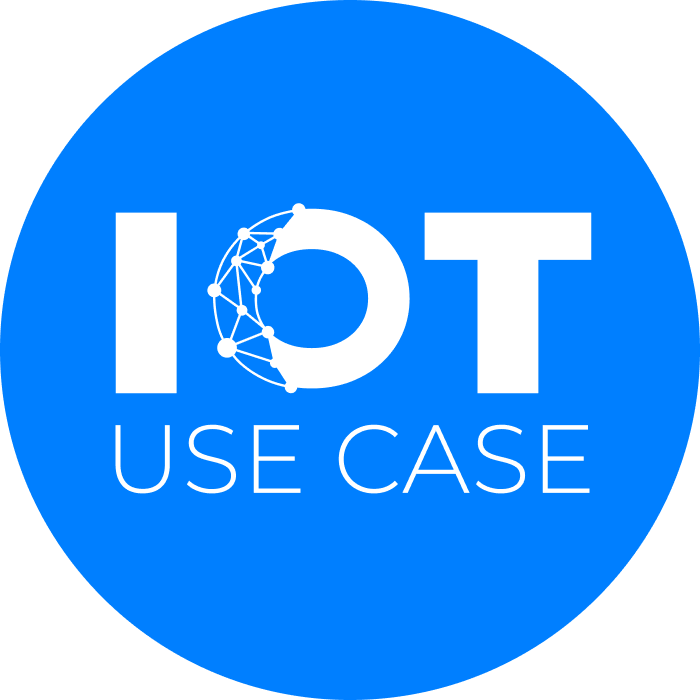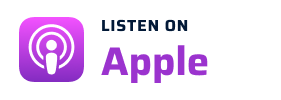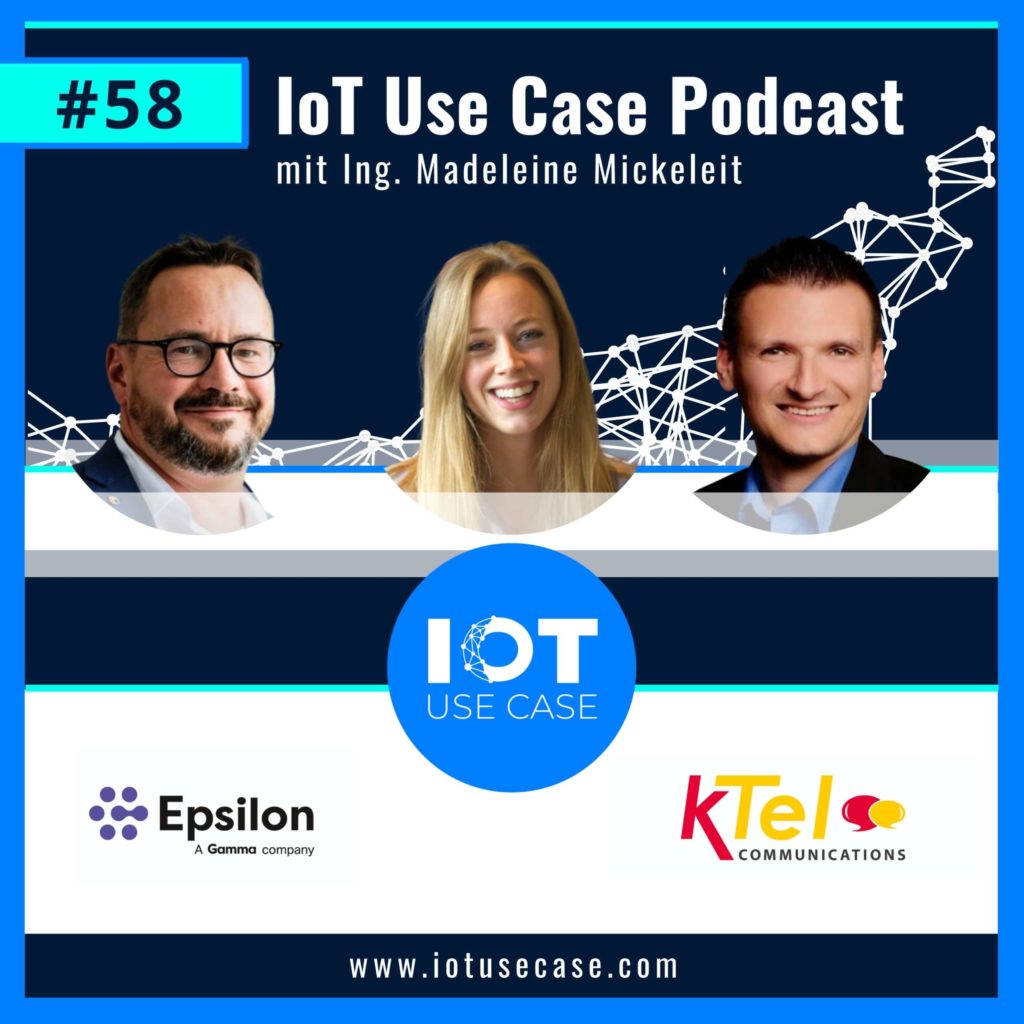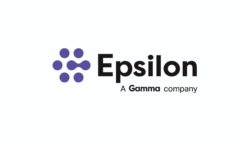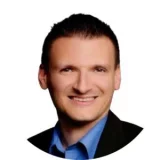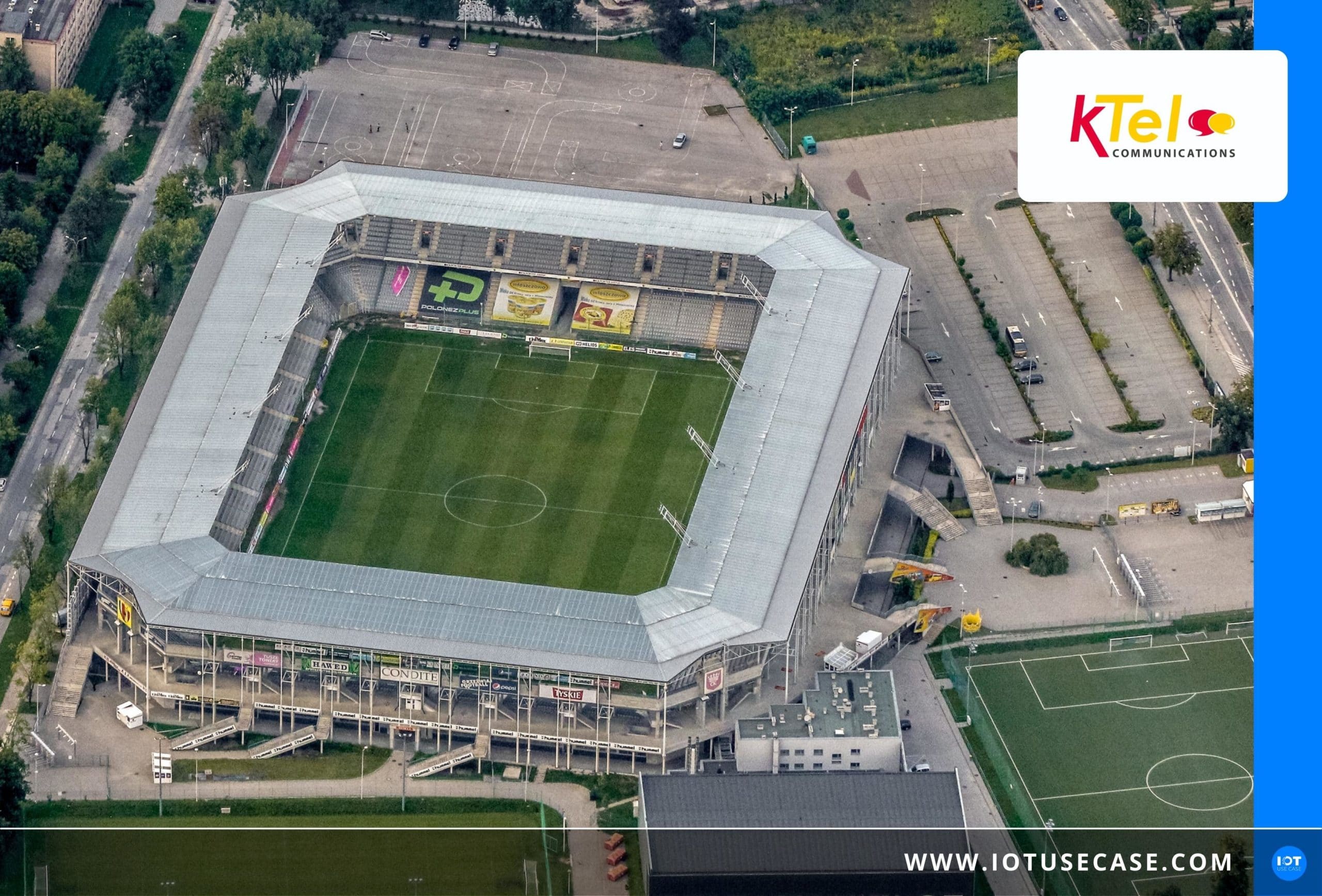In this podcast episode, it’s all about the question: Which mobile network ensures that everything runs as it should in which IoT project? The answer is provided by a wide variety of mobile communications use cases from the field: stadium events, port areas, freeway service stations, pump manufacturers, and many more.
The two connectivity experts Epsilon Telecommunications GmbH from Hof and K-TEL Communications GmbH from Berlin are guests of podcast host Madeleine Mickeleit.
Episode 58 at a glance (and click):
- [12:06] Challenges, potentials and status quo – This is what the use case looks like in practice
- [20:17] Solutions, offerings and services – A look at the technologies used
- [29:07] Transferability, Scaling, and Next Steps – Here’s how you can use this use case.
- [38:41] Results, Business Models and Best Practices – How Success is Measured
Podcast episode summary
Episode 58 is a guide for decision-makers and implementers of communications infrastructures in small and medium-sized enterprises in the manufacturing sector and also in logistics.
3G, 4G, LoRa, NarrowBand IoT (NB-IoT), LTE-M, private networks – no IoT without connectivity. In this episode, we take another look at the buzzwords surrounding mobile communications and the Internet of Things. Which mobile radio is suitable for which IoT project and why? What are the customers’ pain points and what added value can the right connectivity offer?
Epsilon and its partner K-TEL – both represented by their respective managing directors – will be on hand to answer any questions:
- Christian Krug (Managing Director, Epsilon Telecommunications GmbH)
- Boris Krell (Managing Director, K-TEL Communications GmbH)
Epsilon is the most successful German service provider for telecommunications in the business customer segment with over 800 sales partners. K-TEL is an expert in the solutions business for private 5G networks.
More episodes about IoT and mobile communications can be found in our podcast gallery.
Podcast interview
Christian, would you like to briefly introduce yourself, what you have done so far, who you are and what exactly Epsilon does?
Christian
My name is Christian Krug, I am the managing director of Epsilon Telecommunications GmbH and have been doing this in telecommunications for 16 years. I am 53 years old myself and have always had a lot to do with technology. I learned radio and television technology, made a foray into the television business, into marketing; I also studied social pedagogy at one time. I’m in the carrier business, which means we work in an indirect channel, the carrier, and look after around 800 partners who serve German SMEs nationwide on all telecommunications requirements. In the course of digitization, we realized that there are several aspects to the topic of IoT and created the Fusion IoT brand in order to be able to address precisely these needs in a concentrated manner. One of these partners is Boris Krell from K-Tel, who, together with us and a few other partners, is the competence center for Germany on the subject of Fusion IoT.
What exactly is a competence center like this? What are you doing there?
Christian
A competence center is a long-standing partner that has been very successful with us in all telecommunications topics in the SME sector and is now focusing together with us on the requirements of digitization in the SME sector, where it supports and serves customers directly on site.
As far as I know, you have built up a kind of hub, as an information portal for SMEs, everything to do with mobile communications, right?
Christian
That’s right, it’s been online for a week. This is the Epsilon Hotspot, where customers from SMEs but also sales partners can find out about opportunities for digitization and telecommunications for their business. The one or other buzzwords are also explained clearly and transparently.
You’ve already made the transition to Boris, so I’ll turn the floor over to you. Would you also like to briefly introduce yourself and what exactly you do at K-Tel?
Boris
I am Boris Krell, Managing Director, responsible in K-Tel for sales and marketing, especially for the whole project business. That is, everything you do not want to buy directly from the price list. But where you say, I have a question as a customer, I haven’t quite been able to understand this yet – how do you actually do it? What should actually come out of it; what does the customer want? Because I often hear the customer’s request, and they don’t really care how we handle it – the main thing is that it works. 24×7 stress free for him. Whether we solve it this way or that way, then part of my job is to explain that to the customer in a way that we can take them on the journey. Especially with these buzzwords – just google it, you’ll go from the hundredth to the thousandth. The goal is to explain to him in an understandable way what we do here and why it all costs money.
A lot of listeners keep telling me, these are all buzzwords, you have to classify it first and you don’t know where what stands. That’s why I would now like to try to classify the topic of mobile communications for myself – and you will then have to interrupt me in order to establish a basis: What is mobile communications? What is it about radio waves; how does it all work? Everyone knows it; you’re sitting on the train, you’re on the phone, and you’re downloading something from YouTube. The way I always think of it is, I have my cell phone, there’s a green circuit board in there, there’s a SIM card in there. And this SIM card connects to the individual cell towers on the road; are from T-Mobile, Vodafone or Telefónica. I think they always talk about cells in which these radio waves are transmitted in the first place. Let’s assume I am with Aldi Talk. I think it’s called a service provider, which buys the mobile numbers and minutes from T-Mobile and so on, so to speak, and then activates my SIM card. Now, to load something quickly on YouTube, I need a transfer speed. For this, a certain technology must be installed in the network – i.e. the device must be able to do something – and the data tariffs must be activated on the device so that these prevailing frequencies can be transmitted. There are the different frequencies 2G, 3G, 4G and now the big new buzzword 5G. How good the reception is then depends on the ranges. Are we standing somewhere at the station? Are we moving in a tunnel or fast? Then there are volumes of data to be transmitted, with the individual technologies.
Boris
That’s right, that’s where we can get in. You describe very nicely what everyone experiences with their smartphone. This is the mobile technology with the various buzzwords. That simply means that a network-not a carpet-is made available, by the 3 carriers that you have already mentioned, that is an availability, so to speak, so that those terminals can transmit data. Whether that’s voice or video data, that’s secondary. These are public networks that can be used for a fee. Accordingly, this technology has grown, hence the terminology of the numbers: 2G, 3G, 4G, 5G, because that is always the next higher standard. Broadly speaking, that just means enabling higher data rates from 2G to 5G to serve consumers’ hunger for data as more and more is done with video. Train travel is such a nice pain point because these networks are provided via cell towers. Then, whenever you go fast with the train, you have to jump from one pole to the next. These transitions do not always work cleanly. And then we have the issue of high data rates: Let’s take the 5G segment as an example of this. In the public network, you need very strong, i.e., comprehensive coverage, which means many masts in a row or many radio cells in a row. These handoffs don’t always work cleanly. However, we are only in the roll-out phase of 5G. Of course, attempts are being made to sell these 5G rates to customers in order to refinance this massive expansion. But you can actually separate that completely from the applications. Particularly in the area of machine-to-machine IoT, these pure mobile technologies, just as they are available in the public networks, are used to some extent. But there are also very specific wireless technologies that are available for IoT, Internet of Things, and machine-to-machine communications. At the moment, the 4G network is preferable because it has the highest expansion standard.
Right, today we want to talk about exactly that – now I don’t have a cell phone, I have my machines. Maybe sixty, a hundred, thousands of machines, devices, components, even in my production and logistics. They always say Internet of Things, so I have a lot of different things that are transmitting data there. By then, we’re already away from the cell phone mobile network, as the whole thing would go down the tubes. If I were to imagine hooking up all my machines to this public grid: that’s insanely expensive and probably costs a lot of energy. This means that network infrastructures of this kind must now be designed and supplied with technologies that can really do this. And now these are all these buzzwords that I mentioned at the beginning. Did I understand that correctly?
Boris
Yes, that is the question of requirement. It is the customer-specific requirement: What do I need? Do I only need a little data or do I have, for example, a real-time application that transmits data to me in real time? Or can this data be stored to be transferred at a later time? How high must the availability be? Do they also have to be permanently available in a network, if there is a network at all? These are all issues that need to be clarified in advance in order to find exactly the right technology for the particular application. It may well be that some of this also takes place on the public network, and likewise that it takes place closed on the public network. But it may also be that there are technologies that are made available specifically for IoT. Here, the buzzwords are NarrowBand IoT, LTE-M Cat. The topic of 5G is extremely interesting for data-intensive solutions that are highly specialized and ultimately need to be separated from the public network so that there is not this effect of many devices hanging in one network, but instead they can work specifically in a network designed for this purpose.
Challenges, potentials and status quo - This is what the use case looks like in practice
Let’s now take a few use cases from practice so that we can understand what use cases there are for the individual technologies. Christian, let’s start with you. Can you describe what different use cases your customers are struggling with today, and then in the next step classify those technologies, which one exactly do I need.
Christian
There are requirements that simply cannot be mapped in the public network in this way, so that I can go to Aldi, get a data card there and map that. These are mainly applications that take place in areas that are difficult to access, for example. Often these are basement rooms or factory buildings, suitably shielded, where special environmental requirements prevail, such as water pumps. Where operating stands must also be called up only on demand. So not necessarily a control of machines, but certain operating states must be documented and retrieved. These are small amounts of data, but these machines are not accessible via the public networks. There are special technologies for this, which are also provided by the network operators. Keywords here are again NarrowBand IoT and LTE-M Cat, which have high building penetration, certainly also longer latency times. That’s one of those use cases where I say I need a special technology that is made available outside the public network by the carriers in the project case.
That’s the use case if I have reinforced concrete walls somewhere in basements, or hard-to-reach things that are in a building. Whether that’s a water pump, or whatever asset. That would be the use case for this type of equipment?
Christian
Exactly. Then there is a second use case. This one means I have system-critical issues; that I say I have a lot of locations, example of that everyone knows, a rest stop – that in the background of the cashier, advertising is running, on a screen. It is therefore important that these cards can not only function and transmit in one network, but are also available in all three networks. No matter which network is at the location: If one should be available, then this terminal also works. This is so crucial because these individual service stations certainly always have very good Internet connections, but they are closed by the operators. The lessee of the service station cannot access this network infrastructure and needs his own; and the manufacturer, in turn, needs availability in all networks so that he does not have to try it out at every location, so to speak, but can address all three networks with one SIM card – and can go quite classically via the LTE network because this is not system- or security-critical data that is transmitted there.
Do you have an example from the track and trace area as well? When I think about it, I have my fleets somewhere; things that are on the road somewhere. Do you have a use case there as well?
Christian
Basically, it’s similar to a port. In a closed area, there is also the public area and the Europe-wide area, where we say that the logisticians, especially the railroad logisticians, lose thousands of wagons every year because they are parked incorrectly or the papers are gone. In other words, these expensive assets are sitting somewhere on a greenfield site and no one knows where they are anymore, rotting away. There are solutions that are simply attached to the containers and are responsive and say, Hello, here I am!
Boris, now the transition to you. How exactly does this work in so-called private networks? Do you have a few examples from your customers that show what use cases there are?
Boris
We brought two for you today that are often requested. These are also already in the proof-of-concept phase or in implementation. Take what we’re doing right now with Gelsenkirchen, where we’re providing security on the OIL campus, “Open Innovation Lab,” with 5G video surveillance around the stadium so that hundreds of police officers don’t have to be deployed. For example, if a child is lost on the premises. That’s 142 acres – to look for on the site with enormous manpower, where did this kid go now or did someone not act like the rank and file? You wouldn’t be able to do that with normal track-and-trace technology or with video surveillance/flow control, because you wouldn’t be able to get the amount of data from the cameras or sensors. Especially not when several thousand people move somewhere at once for a soccer match or any other event – from the parking lot, from the train station, to the bus. They have to be controlled somehow. We want to use it to make sure that we get all these broad masses backed up by artificial intelligence and therefore by bandwidth on the ground, and that everything moves the way we wanted it to and planned it to. Whether it’s just the curry sausage cart that has to be moved five meters because there are so many people coming, or the traffic has to be diverted because the parking lot on the south side is full. Now you could say, yes, you can do that just as well with Wi-Fi. No, you don’t, because the sheer technology we’d have to deploy to provide Wi-Fi to a 142-acre site like that would swallow up vast sums. Not to mention the cabling and power supply. There is simply the factor of quality and data quality plus environmental influences from outside – plus that we pass on security-relevant information to the police and emergency services here in order to distribute this better information technology. Let’s take five people sitting in front of the monitor as an example. After twenty minutes at the latest, their attention diminishes considerably when they look at such a broad mass. But if I now only show them the things that are really interesting at the moment, where the machine has told me, oh you, something is not going as planned, it looks completely different. A hundred people go to the right and two run once very quickly to the left – then something must be. Then it can be, someone has forgotten his car key or his window is not yet closed. Then again, we see there are suddenly fifty, sixty people moving to the left, in other words, the perceived wrong direction – not to the event, but back to the parking lot: then we would look, okay, what happened there? Do we need to do anything about that? Did anyone leave a backpack lying around? Has anyone missed their child? Has someone fallen down and is lying there and no one cares? These are things that we can narrow down relatively quickly with that. Another example. We are on a port site, there are thousands of containers moving around, with different cargo and freight documents. The biggest factor for those are insurance claims. Our camera captures from the start, has the container been unloaded correctly? Is it loaded at an angle? Did it have the dent before that was reported as a claim afterwards? We can pull all the cargo paperwork online, so we can process it faster to ensure a faster flow. But we can also tell to within a few centimeters, where is this container? Where did it move to? Who moved it? This is largely a matter of efficiency, energy savings and also data security, because not everyone should know where which container is? There again: we can make sure that the data stays on the site, and we can also make sure that we make a better overview available on the site. A port area like this is not only 30 square meters in size, but we may be talking about square kilometers. You have to know where to move what and how. How to coordinate and control the lift trucks that move the containers? If I say we no longer have to wait thirty seconds, but we have a latency of five milliseconds, I can move them completely differently and faster on a site like this than I could have before. Again, laying cables on a site like this is utopian. Nobody tears up the ground in a port area like that, so you have to do something with radio – and Wi-Fi is not a solution there in this case.
Solutions, offerings and services - A look at the technologies used
In the first example, you have different camera systems installed, from specific manufacturers. They record the data in this stadium, in this parking lot, around this building. These are then pre-processed and sent over a private network rather than Wi-Fi. This means that the operator of this building or stadium has set up its own network, where only these assets, whatever data is generated there, really end up in this private network. Did I understand that correctly?
Boris
Yes, the goal should be to provide some kind of security mechanism throughout the site. That we can monitor the site without having to hire umpteen personnel. And that this data is not passed on to third parties for further processing, but remains in our hands on this site. Movement profiles, how did people move? Which parking lot was used frequently? Which one was not used at all? Why hasn’t that been used? Someone standing on an e-charging station, does he even have an e-plate? These are things that I, as a normal operator, am not allowed to know; they are sovereign tasks. We then pass them on and say: Dear police, dear public order office, someone has been standing on a charging station for five hours who doesn’t have an e-car, or in a disabled parking space who has no business there, what are we going to do about it? Simple things like that, but if you had to slay it with staff, it would eat up vast sums of money. A public order office or the corresponding authority would have to walk the entire site in large numbers – over an area of 142 hectares, you can’t walk that in three minutes, you have to deploy a few more people. This is what we can simplify with this.
This issue with the port facilities, it is now the case that you have these containers, for example, or you mentioned the insurance business – that is, I have my containers somewhere, they have a gateway or a trackable board with a SIM card, which again runs in a private network. That is, the operator runs a private network where really only this information is stored in this container location?
Boris
Once it is possible that a chip card is installed in the container, from Christian as an example; and we as port operators do not know who the container really belongs to, but we now record it with cameras, because it also has a serial number and a tonnage, accordingly I know from which ship it comes. When you bring that data together -an IoT card couldn’t do video surveillance of a fully scanned container like that, because we’re talking about image data at immense scales, transmitted in reasonable time and speed. The network is good for that again. And we can pull that across the site a little bit, regardless of where you’re really the end customer. Because there are also containers that are not yet equipped with such a chip. We bring this data together to offer the customer added value from the wealth of information. That’s why it’s also important to talk to the respective operators or idea generators so that they first state their vision of what they would like to have. Then we say, okay, that’s realistic and feasible and that would have to be rebuilt so and so to find a way there.
Now the fact is that you are the expert around this private networks. Operators draw up this network in order to have the data not in the public network and then use the corresponding added values. Christian, now the IoT card, or the SIM card, has just been mentioned. How do you imagine the cooperation here? What comes from Boris; what comes from you? Where do you shake hands?
Christian
We basically shake hands in the project. For the most part, the standardized connectivity comes from our side, the carrier, because we have the appropriate connections from our core business. We map exactly the right technology with the right pricing and also a multi-level billing scenario. We can also approve these topics. That’s why we can offer connectivity tailored to the individualized case of the customer, on the one hand, and to these technologies also with our partner network – to which Boris belongs in the specialization for the private networks – hardware, cloud solutions, everything that takes place around IoT, to bring together in the project and give the customer to hand. If the topic comes up for us or a network partner, but we need something else, we need a private 5G network, for example – or if the topic comes up in the inventory, the ideal thing would be to map something like this with a private 5G network – then we approach Boris and get him on board with this project, or K-Tel.
Now you had just mentioned two other use cases. Once it was about the gas station, the railroad and the pump. So, to put it simply, we don’t have a private network, but it runs on the public network, right? Just to delineate. As an example, you have a customer who is a pump manufacturer. He wants to monitor all his water pumps, hundreds, thousands, in the field. How does it work? What kind of network is that then?
Christian
This is probably a hybrid. Of course, we can combine a wide variety of technologies for the customer. If, for example, he says he is traveling internationally with his pumps and wants to do predictive maintenance – if a certain wearing part is about to wear out, then he would like to know in advance, please, so that he can send the part from Germany to China to have it replaced there: Then we have to go via “normal” network technology so that we are available in all countries as far as network technology is concerned. That’s where we would go over an LTE card. Then there are issues that with the normal wireless network, it has no availability in certain basements or in certain environments. A silo in the middle of the countryside. Then we can offer him technologies that are specifically made for such data connections. These technologies are NarrowBand IoT and LTE-M Cat. Then you just have to know that this has a few prerequisites. Not as much data can be transmitted here; however, the building throughput is very good. This is how the project is customized for the customer from the colorful bouquet of radio technologies. There are also alternative radio technologies that do not run over the mobile network. But buzzwords always pop up there, too. This is the issue of Sigfox or LoRaWAN. These are actually radio standards in their own right. Sigfox for example, publicly rolled out in France, there is a lot of play on IoT through Sigfox. These are then also private networks that are set up themselves via these radio standards. LoRaWAN can also be obtained from K-Tel because they have connections there. We, in turn, come with all the network technologies of the network operator and can implement them in an individualized manner – precisely not in a standardized manner, as the normal network operator offers the customer – even for the smaller medium-sized customer in the project business.
So in the end I have three layers, which always have different characteristics according to requirements. But overall, I always have devices, machines, and sensors like you described – they’re, I’m going to say, at the bottom. Then I have this middle: You have to provide that connectivity. That means I have gateways, e-PCs, or whatever hardware is needed to get a SIM card or a device that’s on that network to talk in the first place. Then this passes that on to a router, to a modem, which then works with these technologies. That’s your business. In other words, you make sure that these routers and modems speak exactly the right language for the customer?
Christian
Exactly, and then also goes one step further. We also take care of data storage, visualization of data and connections of these databases to customer terminals, dashboards in any form. We can do everything from A to Z together in our network – but we don’t have to, because many customers can do parts better themselves. If we take a pump like this, for example. The pump manufacturers have already come up with the idea themselves to install modules and sensors there that fit their pump exactly and read out exactly what they need. But what they can’t do, because it’s not their competency, is feed that data over a wireless network into their cloud and into their dashboard. That’s where we come back into the game, that we say we can also offer pure connectivity alone.
Transferability, Scaling, and Next Steps - Here's how you can use this use case.
Let’s now talk about these technologies that we have now always listed in between for the individual use cases. You’ve actually given me the perfect segue now, and that is, I’m now a manufacturer of, for example, a pump. As you said, the interface is where you bring in your expertise with mobile communications. What do I need to do to reasonably equip this pump with the right mobile technology at my customer’s site? Assuming that this is now installed in a basement, where you don’t have good reception, somewhere in the building: What technology do I use there?
Christian
In that case – especially if it’s not a time-critical real-time application, so you can use a certain amount of time to be able to read this data and you don’t need real-time transmission – we like to go to NarrowBand IoT or LTE Cat-M, which is provided by the respective carriers in their network. What you choose there depends on which carriers you work with, because there are different characteristics there.
Just very briefly, what are carriers?
Christian
Carrier, which is the network operator. In other words, a Telefónica, Telekom or Vodafone in Germany. The network operator offers this technology in its network. However, this must be specially unlocked. There are also different characteristics. For example, NarrowBand IoT is now very well developed at Telefónica and roams, so it also makes use of Telekom’s network. That is why we have a relatively large area coverage on the topic of NarrowBand IoT. NarrowBand IoT has very good building penetration, very high range and low energy consumption for end devices. Here, very long runtimes can be generated with batteries or rechargeable batteries, for example, if it is difficult to access these machines. For example, if you need a term of five to ten years. Likewise, we have low costs and low data consumption here.
You mentioned the example of the railroad. These wagons might also be somewhere in the subway, but let’s now assume that would be somewhere above – how does it work there? What is the optimal technology here for monitoring all these wagons?
Christian
We use the public LTE network with our own APN. Own APN describes that this card can not be seen by other devices. In simpler terms, that’s a security aspect, that it sort of operates closed on the public network, with the same standards. Here it is important that these cards work if there is a network at all – Telekom, Telefónica or Vodafone. If one of these networks is available, then this data can be transmitted or tapped. As a rule, this is simply location data. You can, of course, track cold chains with something like this. This usually all happens in the public network, because this network is already available – with the special feature that we often work in all three networks with one SIM card, so that, if a network is available at all, these technologies also work.
And with the safety aspect that this is then also built in accordingly?
Christian
Exactly, that they run over their own APN, and not a public one.
Boris, you had now also mentioned two use cases. The subject of Gelsenkirchen. If I am now the operator of a stadium, of a building: Which technology is the right one here to do this camera surveillance on an example? What do I need for this?
Boris
Maybe let’s go back to what we actually do for the customer. Just such a site or industrial park operator has a different need than we do, because we do engineering and operations and service every day – and he says, I’m a site operator, I’d like to do something. They just say, okay, of course I can manage my data myself, I’m good at it myself; but the technology we need to set this in motion is then handed over to people like us, or they ask whether we can do it. That’s always such an intermediate step. Who does what by the end of the day? Customers want this to run. Sure, let’s take my car tires as an example. I could change those too, or just drive to the manufacturer and tell them to do it for 29 euros. They do it ten times a day, and probably three times more professionally than I do. There is also a cost-benefit factor involved, who does what to where? We offer from-to where the customer says, no, I’d rather do that on my own. We then say, no problem, then we’ll hand that part over to you and then we’ll run that for you together. On the question of how we approach such a project: The first thing is that talking helps. First, outline what the customer wants. How will he have that? What does he actually want to achieve with this? In the case of Gelsenkirchen – Open Innovation Lab – the requirements were security in public spaces and crowd control at events. In that case, the decision was relatively clear, there will be tens of thousands of people coming to an event, a soccer game, when public events are allowed again. That you then say, you can’t manage that with normal on-board means, Wi-Fi is simply too slow for that and the data throughput is too high. It quickly became clear that we needed a real-time application, we needed data sovereignty and data security so that no third party could access this data. People checks, vehicle checks or parking space occupancy – these are things that have to stay with us, they have to be available even in sovereign use, and they have to be reliably available 99.9 percent of the time, not just 98 percent of the time. It does me no good if the system goes down half an hour before the game starts because there are too many users on the site. Ergo, the decision was simple, to say we need this over a large area in real time, with a lot of data volume, in a short time. It was clear to us that this would only work with this one system. We then worked our way up to it. For example, they already had cameras in place – so we don’t have to set everything up again either. As long as the camera speaks IP and meets our requirements, you can theoretically take a 300 euro camera. Because the intelligence – that’s another difference – is no longer on the device, but in the network. So you’re pulling capacity from the infrastructure and moving it to the on-premises solution that’s tied to the site, even if that’s a big server. But it’s on site, not in a data center in England or somewhere else.
Then you gave the example of the port. If I am a port operator and have all my containers there, might want to map insurance use cases: How do I do that? Is that then similar to Gelsenkirchen, that you go into a private network? Or how do you lay out the network infrastructure there?
Boris
The procedure is almost identical there, too, except that the case is completely different. Again, big site, lots of data, lots of possible users – you’ve got container ships, dockworkers, logisticians, truck drivers, tankers, cleaners and crews on the ship. You have a lot to do with customs. So you have quite a few people who actually want the same thing, but no one is giving away the other person’s data. Container operator A should not know that container operator B is also there. So you have to put an identity in between that says, I as a port operator care about your concerns because I make money from loading and unloading, not from trading the goods. The port operators have nothing to do with this. However, they bear all the risk of how what is planned and what has to go where; who has to bring what customs paper from A to B. Data sovereignty lies with the individual, and that’s where we introduced multi-client capability: Everyone only sees the data that really belongs to them. So I only see my ship, and not my competitor’s. Who is treated where and how? Who gets which data accesses? Just by loading more efficiently or having more efficient vehicle routes on the site, they’re saving vast sums of money because they don’t have to do it with personnel or barrier hooks or other things. Instead, the computer knows what needs to be loaded where and how an hour before the ship even arrives at the port. Where is a cold chain? Which container needs to go down quickly? How must it be stored? Or are there special customs papers because there are some high security things in there. Or simply, a shipload of iPhones may be more than a shipload of children’s toys – but we wouldn’t know that if we didn’t know what was on those cargo papers. Bringing all that together into one database of what needs to be treated and how is an efficiency gain they didn’t have before.
You make sure, so to speak, that the optimal technology is then used and that the private network is set up in a way that all the data volumes are processed properly so that that can be made available to the operator at the end.
Christian
That’s right, we make sure he can work smarter and more efficiently. I’m not even interested in what that data is, I just need to understand what he wants to do with it and who I need to provide that information to. Say, do I need to train employees, and say why are we building a new network here? You need to take people on the journey of why we’re building “new stuff” here again. Change only ever appears to be beneficial for a limited group of users. You have to explain to people what we do here – it doesn’t kill jobs, it lets you focus on the things that are important to you.
Results, Business Models and Best Practices - How Success is Measured
I think these use cases give us a very good understanding of the individual technologies that are used. Towards the end, I would be interested to know again, what is the business case now? It’s about the return on investment or the cost savings that I have with it. Do you have any best practices you can share to help avoid mistakes and costs? Christian, as a question to you: You have a wide variety of customers from different sectors. What is the business case for your customer? And what pitfalls can you point out that you say kind of affects all customers? Maybe you can give some more insights.
Christian
What we have found in recent years is that there are rarely off-the-shelf products for these customers. That’s why network operators are also having a hard time here: because they are forced by their positioning to offer standardized products. We have noticed through our 800 sales partners, who sit down with SMEs every day, that these are highly individual pains that SMEs have, which also have to be addressed individually. We therefore say: Speak. Talk to the right people, and talk to people who are independent. We can claim this independence. We are connectivity-independent because we are not our own network operator. We don’t just need to include a network operator’s products in these projects. We are also free to design the hardware and sensor technology. We can provide independent advice for the customer and help with implementation accordingly.
And customers have to bring time with them, because these projects aren’t even done quickly. This requires manpower in the company as well as training and change management to bring employees along with them into the companies. These are comprehensive projects. If topics in an industry could possibly be standardized there, because we have worked out such solutions with the customers, it is also easier for the customer in this industry to approach us again, because they can then find all these solutions in the GK-Hub.
We’ll link that in the show notes so people can find the contact to you as well. A question for you Boris. We discussed use cases from your customers. What is the business case regarding private networks for your client and what pitfalls, best practices do you know that you can share?
Boris
For us, you can sum it up by saying that we are in the beginning of the fourth industrial revolution because data is the new gold. Most customers have this data, but not at the speed, quality and grade they might like. What is there simply has to be implemented and brought to that. That’s also where we’re talking about competitive advantage and disadvantage. Take the container or clearance at an event. If before that it took you 15 to 30 minutes to get a container ready for service. For shipping, landing on the truck and further. Or, on an industrial production floor, getting the flow of goods ready for finished product and shipment. If we say we can save you 75 percent time, that can be converted into cash relatively quickly. Of course, I can only do that to a limited extent because I don’t know the internal key figures. But I can say to the customer, if you do this and that, we assume that your time to process this will go down by a significant amount. This gives you a competitive advantage because your competitor doesn’t have this at the moment. This also applies not only to large port operators, but also to smaller industrial production sites. We are doing something together with the Fraunhofer Institute, where we track the devices on the site. For example, where are particularly expensive tools in a work yard? If a tool like that costs 20-30,000 euros because it can do certain things that others can’t – before you would have to buy five of them because you just don’t know who has them and who had them and for how long, you save money that way. Or before the railroad leaves for the depot, you already know what needs to be repaired. Those are the kinds of things we can do with it. Talking helps immensely there, too. There is no one solution, because if there were, the original network operators would not be struggling so much. The truth lies in the middle. We always have to add something that is not available in the standard product. We are equipped for this. We have the global view – what else can you buy somewhere? What is there perhaps in the USA, in Canada, in Mexico or simply in Austria that no one knows here at first because it cannot be sold ten thousand times a week? But there may only be 50-60 users – but for them it has a significant added value. We attach great importance to this, that we are a gathering place of information: We have a lot of things, the wide range of partners and suppliers, that the normal end customer, because he deals with it once a year, can’t have.
I would totally underline that. The customer has knowledge of the processes and probably knows the return on investment or what an hour or a failure costs. These are the individual processes. But I believe that you can learn a lot from such use cases, because they are always similar approaches, with similar logic behind them. Many learning curves have already been taken; many topics you have already gone through with your customers, and there one can profit from your knowledge, which has been built up over years. Everyone has the focus on their competencies. You clearly have that in your area and the customer has that in his area – so that brings everyone forward in the context of IoT and digitalization, that learning can be done together on the basis of such projects.
